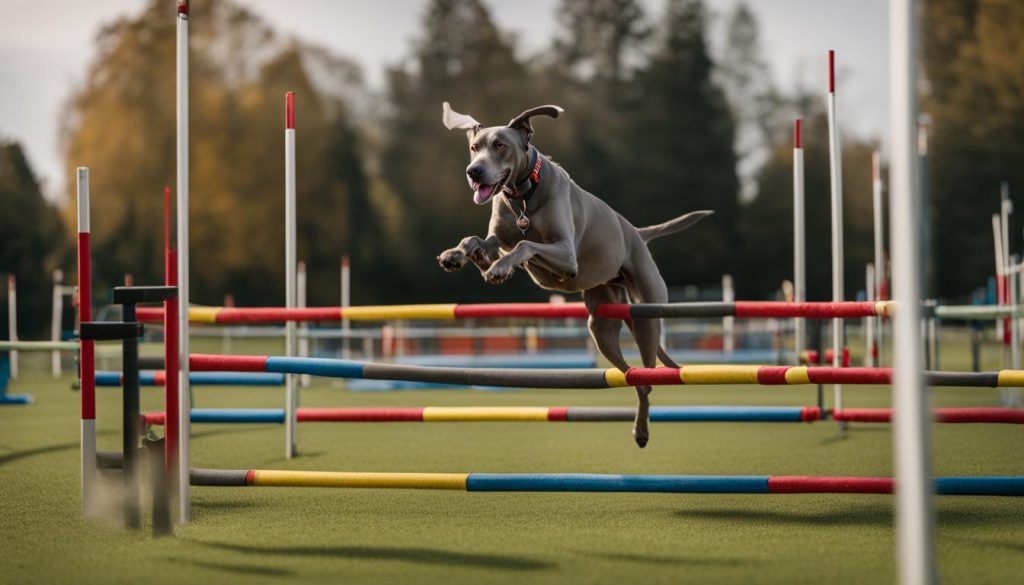Welcome to my comprehensive guide comparing the Weimaraner and Doberman Pinscher breeds. If you’re considering adding a new furry friend to your family, this article will help you understand the breed differences, temperament, physical characteristics, exercise needs, training, grooming, and intelligence of these two popular choices. Whether you’re looking for a loyal and active companion or a protective guard dog, we’ll explore the key factors to consider in making the right choice for your lifestyle and preferences.
Key Takeaways:
- Both Weimaraners and Doberman Pinschers make excellent family pets, but they have different temperaments and exercise needs.
- Weimaraners are known for their intelligence, trainability, and loyalty, while Dobermans are affectionate and great guard dogs.
- Weimaraners have a stocky build and muscular physique, while Dobermans are slightly larger and have a strong physique.
- Both breeds require regular exercise, but Weimaraners need more physical activity to prevent excessive energy.
- Weimaraners have low grooming needs with their short coats, while Dobermans require moderate grooming.
- Training is essential for both breeds, with Weimaraners being highly trainable and Dobermans requiring consistent training to manage their protective instincts.
- Consider your lifestyle, family dynamics, and your preferences for temperament and activity level when choosing between these two breeds.
Visual Differences
In this section, we will explore the visual differences between Weimaraners and Doberman Pinschers, including their average height, weight, lifespan, exercise needs, grooming needs, and their compatibility with other pets and families. Understanding these distinctions will help you make an informed decision when choosing your ideal companion.

| Breed | Average Height | Average Weight | Lifespan | Exercise Needs | Grooming Needs | Family-Friendly | Other Pet-Friendly | Trainability |
|---|---|---|---|---|---|---|---|---|
| Weimaraner | 23-26 inches | 55-82 lbs | 11-14 years | At least 2 hours per day | Low | Yes | Yes | Easy to train |
| Doberman Pinscher | 24-28 inches | 71-88 lbs | 10-13 years | At least 2 hours per day | Low | Yes | Yes | May require more training |
As shown in the table above, Weimaraners have an average height of 23-26 inches, while Doberman Pinschers are slightly taller, measuring between 24-28 inches. Weimaraners also have a slightly lighter average weight of 55-82 lbs compared to the 71-88 lbs of Doberman Pinschers. Both breeds have similar lifespans, with Weimaraners living for 11-14 years and Doberman Pinschers for 10-13 years.
When it comes to exercise needs, both breeds require at least 2 hours of physical activity per day. Weimaraners and Doberman Pinschers have low grooming needs, making them easier to maintain compared to breeds with longer or double coats. Both breeds are considered family-friendly and get along well with other pets. While Weimaraners are generally easy to train, Doberman Pinschers may require more training due to their slightly higher level of independence.
Overall, the visual differences between Weimaraners and Doberman Pinschers are relatively minor. The decision between the two breeds should be based on factors such as exercise requirements, grooming needs, trainability, and compatibility with your family and other pets.
Weimaraner Overview
The Weimaraner is one of the most popular dog breeds in the United States, known for its German and Norse roots. This versatile breed has a rich history of being used as a livestock guardian and pointer dog. With its athletic build and alert demeanor, the Weimaraner is both stunning to look at and highly capable in the field.

Weimaraner Breed History
Originating from Germany, the Weimaraner breed was developed by nobles and royals to hunt large game, such as bears and deer. Its distinct silver-gray coat and striking amber-colored eyes make it easily recognizable. Over time, the Weimaraner’s hunting skills and versatility led to its popularity as a working and companion dog.
Weimaraner Physical Characteristics
The Weimaraner has an athletic build with well-defined muscles, allowing it to excel in various activities such as agility, tracking, and obedience. This breed has a sleek, short coat that requires minimal grooming. With proper care and exercise, the Weimaraner can maintain its fit and healthy physique.
| Physical Characteristics | Weimaraner |
|---|---|
| Average Height | 23-26 inches |
| Average Weight | 55-82 lbs |
| Lifespan | 11-14 years |
Weimaraner Temperament
Weimaraners are known for their friendly and affectionate nature. They form strong bonds with their families and are highly devoted. While they are good with children and other pets when properly socialized, their high energy levels may not be suitable for households with young or frail individuals. Weimaraners thrive in active households that can provide them with ample mental and physical stimulation.
Weimaraner Personality and Character
The Weimaraner is a highly intelligent and people-oriented breed known for its affectionate nature and high energy levels. These dogs thrive on human companionship and form strong bonds with their owners, making them beloved family pets. However, their high energy levels and intelligence require consistent training and mental stimulation to keep them happy and well-behaved.
One of the defining traits of the Weimaraner is their people-oriented nature. They crave human interaction and can become anxious and destructive if left alone for extended periods. Weimaraners are known for their affectionate behavior and love to be involved in family activities. While they are generally friendly, they may be too boisterous for young children and can accidentally knock them over during play.
Training is essential for Weimaraners due to their intelligence and high-energy levels. These dogs excel in various activities, including obedience, agility, and fetch. Regular training sessions not only help Weimaraners master commands but also provide mental stimulation to prevent boredom. I recommend that you establish clear boundaries and consistent rules to ensure a well-behaved and happy pet.
| Personality Traits | Lifestyle Suitability |
|---|---|
| Intelligent | Weimaraners thrive in active households and require mental stimulation. |
| People-oriented | They form strong bonds with their owners and crave human companionship. |
| Affectionate | Weimaraners love to be involved in family activities and show affection to their loved ones. |
| High-energy | Regular exercise and mental stimulation are necessary to prevent destructive behavior. |
| Training | Consistent training sessions are essential to harness their intelligence and maintain good behavior. |
The Weimaraner’s intelligence, people-oriented nature, and high-energy levels make them excellent companions for active individuals and families willing to invest time and effort into training and exercise. With the right care, these dogs can bring joy and endless fun to their owners’ lives.

Weimaraner Training
Training a Weimaraner is an essential part of owning this smart and loyal breed. Weimaraners are known for their eagerness to please their owners, making them highly trainable. However, due to their high energy levels, consistent and comprehensive training is crucial to channel their energy in a positive direction.
A key aspect of Weimaraner training is establishing a routine that includes at least an hour of training each day. This helps to stimulate their minds and prevent them from becoming too energetic or restless. Training sessions should be engaging and interactive, using positive reinforcement techniques such as treats, praise, and play.
In addition to basic obedience commands like sit, stay, and come, focus on socialization and leash training. Weimaraners are social dogs but may be wary of strangers if not properly exposed to different people, animals, and environments from a young age. Leash training is also essential to ensure they can be safely controlled during walks and outdoor activities.
Training Tips for Weimaraners:
- Start training your Weimaraner from an early age to establish good habits and a strong bond.
- Use positive reinforcement techniques, rewards, and praise to motivate and encourage desired behaviors.
- Be consistent and patient with your training, as Weimaraners can be sensitive to changes in routine.
- Provide mental stimulation through puzzle toys, obedience training, and interactive games.
- Enroll in obedience classes or work with a professional trainer to enhance your training techniques and address any specific challenges.

To put it simply, training a Weimaraner requires time, effort, and dedication. With consistent training and positive reinforcement, you can help your Weimaraner become a well-behaved and obedient companion.
Weimaraner Grooming & Maintenance
Keeping your Weimaraner’s short coat looking its best is relatively low maintenance. Regular brushing helps to prevent mats and keep their coat healthy. They have minimal shedding compared to double-coated breeds, making them a suitable choice for those who prefer a cleaner home environment. A gentle brushing once a week is usually sufficient to remove any loose hairs and keep their coat looking sleek and shiny.
When it comes to grooming your Weimaraner, attention should also be given to their nails and ears. Like all dogs, their nails should be trimmed regularly to prevent overgrowth and discomfort. If you’re not comfortable trimming their nails yourself, it’s best to seek professional help. Additionally, check their ears regularly for any signs of wax buildup or infection. Cleaning their ears with a dog-specific ear cleaning solution can help prevent issues and maintain their overall ear health.
To summarize, Weimaraners have a short coat that requires minimal grooming. Here are the key grooming tasks to keep in mind:
- Regular brushing to prevent matting and maintain a healthy coat
- Trimming their nails to prevent overgrowth and discomfort
- Checking their ears regularly for any signs of infection or buildup
With these simple grooming tasks, you can ensure that your Weimaraner looks and feels their best, while also staying healthy and happy.
Grooming supplies for your Weimaraner:
| Grooming Supplies | Description |
|---|---|
| Grooming brush | A soft-bristle brush to remove loose fur and keep their coat tidy |
| Nail clippers | Specifically designed for dogs, to safely trim their nails |
| Ear cleaning solution | To keep their ears clean and prevent infections |
“Regular grooming not only keeps your Weimaraner looking their best, but it also provides an opportunity for you to bond with your furry friend. Make grooming a positive experience by rewarding your Weimaraner with treats and praise.”
Weimaraner Health
When considering the health of Weimaraners, while they are generally considered fairly healthy dogs, they are susceptible to certain hereditary conditions. These conditions can have a significant impact on their overall well-being and quality of life.
Hip Dysplasia
One common hereditary ailment that affects Weimaraners is hip dysplasia. This condition occurs when the hip joint doesn’t develop properly, causing instability and leading to pain and mobility issues. It can be managed through medication, physical therapy, and sometimes surgery.
Spinal Dysraphism
Another hereditary disorder seen in Weimaraners is spinal dysraphism. This condition affects the spinal canal and can cause walking difficulties and other neurological symptoms. Treatment options may include surgery and ongoing management to alleviate symptoms and improve the dog’s quality of life.
Von Willebrand’s Disease
Weimaraners are also prone to Von Willebrand’s Disease, a bleeding disorder caused by a deficiency of a specific clotting factor in the blood. Dogs with this condition may experience increased bleeding after injury or surgery. While there is no cure, treatment typically involves managing symptoms and taking precautions to prevent excessive bleeding.
Hypertrophic Osteodystrophy
Lastly, Weimaraners can be affected by Hypertrophic Osteodystrophy, a condition that causes inflammation and swelling in the bones. It primarily affects young, growing dogs and can cause pain and lameness. Treatment usually involves medication and supportive care to manage pain and reduce inflammation.
while these hereditary ailments are more common in Weimaraners, not every dog will develop them. Responsible breeders should conduct health screenings on their breeding dogs to help reduce the risk of passing on these conditions to future generations.
| Condition | Description | Treatment |
|---|---|---|
| Hip Dysplasia | Abnormal development of the hip joint leading to pain and mobility issues | Medication, physical therapy, surgery |
| Spinal Dysraphism | Disorder affecting the spinal canal, causing walking difficulties and neurological symptoms | Surgery, ongoing management |
| Von Willebrand’s Disease | Bleeding disorder due to a deficiency of a clotting factor in the blood | Managing symptoms, precautions to prevent excessive bleeding |
| Hypertrophic Osteodystrophy | Inflammation and swelling of the bones, primarily affecting young dogs | Medication, supportive care |
While Weimaraners may be more prone to these hereditary ailments, I would advise that you remember that early detection, proper management, and regular veterinary care can significantly improve their overall health and well-being.
Doberman Overview
The Doberman Pinscher, often referred to as the Doberman, is a versatile and intelligent breed known for its loyalty, strength, and active lifestyle. Originally bred to be guard dogs, Dobermans are also commonly used as police dogs due to their keen sense of smell, agility, and trainability. With their muscular build and alert demeanor, Dobermans make excellent companions for individuals or families who lead an active lifestyle and seek a devoted and protective canine companion.
Dobermans have a reputation for being loyal and dependable. They form strong bonds with their owners and are often protective of their families and property. This loyalty, combined with their natural strength and athleticism, makes them excellent guard dogs. Dobermans are known for their courage and will not hesitate to defend their loved ones if they feel threatened.
To ensure a well-rounded and obedient Doberman, proper training is crucial. These intelligent dogs thrive on mental stimulation and require consistent and firm guidance from an early age. Training should focus on establishing clear boundaries and socializing the Doberman with different people, animals, and environments. With the right training approach, Dobermans can become well-mannered family pets while retaining their natural protective instincts.
Doberman Pinscher Characteristics:
- Guard dogs and police dogs
- Loyal and protective
- Strong and muscular
- Active and energetic
Doberman Pinscher Training Tips:
- Start training early to establish boundaries.
- Use positive reinforcement techniques to encourage desired behaviors.
- Expose the Doberman to a variety of social situations to promote good behavior in different environments.
- Be consistent and firm in your approach to establish yourself as the pack leader.
In summary, the Doberman Pinscher is a loyal, strong, and active breed that excels as a guard dog and police dog. With proper training, socialization, and an active lifestyle, Dobermans can be loving and devoted family pets. Consider these characteristics and training tips when deciding if a Doberman Pinscher is the ideal companion for you.
Doberman Personality / Character
Doberman Pinschers are known for their loyal, sweet, and loving nature. They form strong attachments to their owners and are highly devoted to their families. These dogs have a reputation for being intelligent and have a natural sense of courage, which makes them excellent guard dogs. However, you should note that while Dobermans can be incredibly loving and gentle, they can also display aggression if they are not properly trained or if they feel threatened or bored.
Training plays a crucial role in shaping the personality of a Doberman Pinscher. With consistent and positive reinforcement training methods, Dobermans can become well-behaved, obedient, and loyal companions. Their high intelligence makes them quick learners, and they thrive when given mental stimulation and tasks to complete. By providing them with proper training and socialization from a young age, owners can help Dobermans develop into confident and well-mannered dogs.
When it comes to loyalty, Dobermans are second to none. They will always prioritize protecting their loved ones and will go to great lengths to ensure their safety. This unwavering loyalty is one of the reasons why Dobermans are often used as police dogs and search and rescue dogs. Their courage, combined with their intelligence and trainability, makes them an excellent choice for these demanding roles.
Doberman Pinscher Personality Traits:
- Loyal
- Sweet
- Loving
- Intelligent
- Courageous
- Aggressive (if not properly trained or if they feel threatened or bored)
To sum it up, the Doberman Pinscher is a loyal, sweet, and loving breed known for its intelligence, courage, and loyalty. While they require proper training and socialization to prevent aggression, Dobermans can make excellent family companions when raised in a loving and structured environment. Their protective nature and unwavering loyalty make them highly desirable as guard dogs, police dogs, and search and rescue dogs. With the right training and care, a Doberman Pinscher can be a wonderful addition to any family.
Final Thoughts
When deciding between a Weimaraner and a Doberman Pinscher, consider your specific preferences and lifestyle. Both breeds have their unique qualities and characteristics that make them suitable companions for different types of families.
Weimaraners are intelligent and active dogs, making them ideal for families with older children who can keep up with their energy levels. They have low grooming needs and are generally easy to train, which can be advantageous for first-time dog owners.
On the other hand, Doberman Pinschers are known for their loyalty and affectionate nature. They are often used as guard dogs and may require more training to ensure their protective instincts are properly directed. With their slightly larger size, Dobermans can provide a sense of security while still being loving family pets.
Consider the differences in temperament, physical characteristics, exercise needs, training requirements, grooming demands, and intelligence levels of the Weimaraner and Doberman Pinscher breeds to determine which one will be the ideal companion for you and your family.
FAQ
What are the main differences between a Weimaraner and a Doberman Pinscher?
Weimaraners are medium-sized hunting dogs known for their intelligence and great temperaments, while Dobermans are gentle and affectionate family companions with a keen sense of smell. Weimaraners are slightly smaller in size and have lower grooming needs compared to Dobermans.
How much exercise do Weimaraners and Dobermans require?
Both Weimaraners and Dobermans require at least 2 hours of exercise per day to stay happy and healthy.
Are Weimaraners and Dobermans good with children and other pets?
Weimaraners are considered family-friendly and other pet-friendly, but may be too aggressive for young children. Dobermans are also family-friendly and other pet-friendly, but proper training is necessary.
How easy are Weimaraners and Dobermans to train?
Weimaraners are smart and trainable dogs. They are loyal and eager to please their owners. Dobermans are also intelligent and trainable, but may require more training due to their high energy levels.
What are the grooming needs of Weimaraners and Dobermans?
Weimaraners have short, flat, single coats that require low maintenance. They don’t shed as much and only need to be brushed once a week. Dobermans also have low grooming needs and require regular brushing.
What are the common health issues in Weimaraners and Dobermans?
Weimaraners are susceptible to hip dysplasia, spinal dysraphism, Von Willebrand’s Disease, and Hypertrophic Osteodystrophy. Dobermans are prone to certain genetic conditions, including dilated cardiomyopathy and von Willebrand’s Disease.
Are Weimaraners and Dobermans suitable for an active lifestyle?
Yes, both Weimaraners and Dobermans are active dogs that thrive in households with an active lifestyle.
Which breed is better suited for families with older children?
Weimaraners are generally well-suited for families with older children. However, both breeds can be wonderful family companions with proper training and socialization.






